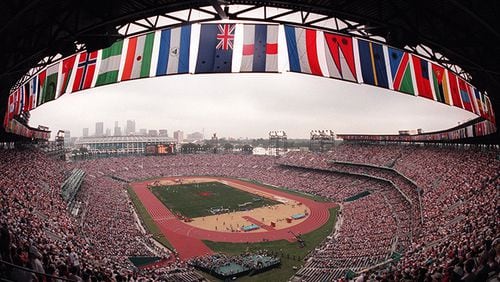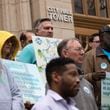By Helena Oliviero
Before the home runs and double plays, before the no-hitters and what-about-them-Braves moments, other heroics took place at this stadium in Atlanta.
Michael Johnson, wearing customized, gold-colored track shoes, won the 200-and 400-meter dashes in front of about 80,000 screaming spectators. A trembling Muhammad Ali lit a huge torch – touching off not just the 1996 Olympics, but a spot in our collective heart.
Once the Olympic flame went dark, signaling the end of the Games, something else took shape where heroes were made. Centennial Olympic Stadium became Turner Field - a stadium free and clear of debt.
Call it a masterpiece of planning, of foresight. While Olympic venues often struggle to find a future purpose, Atlanta seemed to have it all figured out long before the flame flickered its last. It was clear the Olympic stadium was built for baseball - you could easily make out the horseshoe shape of baseball stands at one end.
And for the past 20 years, the Olympic stadium has been home to the Atlanta Braves, a hive of energy, where a steady stream of tens of thousands of baseball fans filled the brick-and-limestone structure. It’s the place where the Braves won nine of their 14 division titles.
It’s where Greg Maddux, John Smoltz and Tom Glavine continued their dominance as the greatest trio any one rotation has ever possessed.
It’s where Chipper Jones joined an elite group of players when he hit his 400th home run on a summer day in 2008. It’s also where Jones, during his final season in 2012, blasted a two-run walk-off homer in the bottom of the ninth with two outs to give his team a comeback victory 8-7.
And yet …
Turner Field, long cited as the smart way to repurpose an Olympic venue, is closing. When the lease expires after the 2016 season, the Braves are stepping away from Atlanta to take their game to Cobb County. Stadiums, like Olympic flames, eventually go dark.
What does that mean for the legacy of a stadium only 20 years old?
Though the stadium won’t be reduced to rubble, it will gain a new name, a new purpose, a new life.
The baseball stadium is expected to remain standing and be converted into a football stadium for Georgia State University, which along with its development partners, plans a mix of student housing, apartments, classroom space and retail around it.
The iconic Hank Aaron statue at Turner Field and the Olympic cauldron will also remain in downtown Atlanta although exactly how these historic landmarks will be incorporated into a massive piece of property stretching 67 acres has not yet been decided.
But Turner Field will no longer be home of the Atlanta Braves, no longer a vestige of the Olympics.
Shirley Franklin, who worked on the Olympic committee, said while she, as a former mayor of Atlanta, would love to see the concentration of professional sports remain in the city, she would refrain from expressing an opinion about the move to Cobb County.
“Certainly the Olympics left an indelible mark on the city and state and Turner Field was an important part of the memories. I don’t think you can ever erase that, whether it’s knocked down or someone else is using the field. I don’t think the memorable pictures will ever be lost.”
An enviable transition Atlanta’s Olympic organizers built the Olympic stadium with $200 million of private money from ticket sales and sponsorships. Right after the Games, the 80,000-seat venue was converted into a 50,000-seat baseball stadium.
It was the Olympics’ gift to Atlanta.
Over the years, the Olympics have left behind an ever-growing group of “white elephants” - elaborate ventures, buildings that prove very expensive to maintain, and are sometimes even useless. One recent example includes the seemingly impressive “Bird’s Nest” venue, a grandiose palace of steel built for the 2008 Beijing Olympics. It has since been coined “empty nest” because the building sits mostly empty with a smattering of visitors paying about $8 to tour the former Olympic centerpiece.
A recent European study by Leisure Studies publication found no venue built for a major sporting event - which included not only Olympic venues but World Cup stadiums - since the 1996Olympicshasbeenmore effective than Turner Field.
Since opening in 1997, Turner Field has averaged close to 30,000 people at about 80 games a season.
Economist Bruce Seaman of Georgia State University said, “It is much easier to recall sad examples: Athens, Sarajevo, ‘Bird’s Nest’ from Beijing … Turner Field was a much smoother transition to a useful facility.”
—- Views of future differ
For many fans, Turner Field is a lasting landmark from the 1996 Olympics. But reaction from fans about the move to Cobb and what it means for Turner Field ranges widely, perhaps a sign of whether they attach a legacy to a place - or to the people who have made that place special.
Ted Rubenstein is disgusted by the move, and the man who used to go to 30 games a season hasn’t even watched a single game since the Braves announced moving.
“Legacy? What legacy? Why walk away from a stadium that is paid for? That was a gift from the 1996 Olympics. I don’t get any of it, “ said Rubenstein, who lives in Atlanta and is managing partner in a video production company, SplendidVid.
Rubenstein was turned off by the secrecy of the move. He is angry about the new Braves stadium relying on taxpayer funds and that decisions were made with “virtually zero citizen input.”
(The new stadium became an issue in Cobb Commission Chairman Tim Lee’s re-election bid this year. Lee lost in runoff against Mike Boyce on July 26.)
Others, however, are taking the departure from Turner Field in stride.
For Seaton and Lucille Smith, who are in their early 80s, Turner Field feels like home. Season ticket holders since 1990, they have grown close to ushers, vendors, security workers.
This close: Workers at a hamburger concession start grilling his hamburger and saute onions for Seaton Smith the moment they see him get in line. Once when the Smiths’ keys fell into a drain in the parking lot, an employee at the gate told the couple to head to their seats; 45 minutes later, the fished-out keys were delivered to the Smiths. They get hugs at the gate - lots of them.
“We usually get four hugs at the gate, “ said Seaton Smith, wearing a blue-collared Braves shirt.
They rarely miss a home game.
“We love Turner Field, “ said Seaton Smith.
His wife smiles and added, “Yes, we really do.”
The couple split their time between a house in McDonough (purchased because of its proximity to Turner Field) and Pensacola, Fla. With the Braves moving, they recently put their house in McDonough on the market.
“The way we look at it, we are making the move together, ” said Lucille Smith.
What’s next? Right from the start, even though Turner Field sat less than one block from Atlanta-Fulton County Stadium, which served as the Braves’ ballpark from 1966 to 1996, the ballpark faced challenges.
Turner Field, about 2 miles south of Centennial Olympic Park, is not really downtown - but rather south of downtown. Surrounded, even cut off by highways, the area doesn’t blend into the city. And the communities around Turner Field never flourished as hoped.
The lack of easy access to public transportation was an ongoing, nagging issue. The Braves shuttle was far from ideal. (Though the Cobb stadium will have far more parking, traffic and a lack of public transportation are expected to be issues there, too.)
In addition, the Braves wanted to control and develop city-owned property around Turner Field in hopes of turning it into a mixed-use development that would buzz with activity even when the ballpark is empty.
Turner Field will likely be used as the home of Georgia State’s football team, with the team playing there as early as next year.
Atlanta-based real estate developer Carter and Georgia State University have teamed up on a proposal to redevelop Turner Field and the property around “the Ted” for multiple uses, including football and baseball stadiums, retail, and residential and student housing.
“Atlanta has an incredibly rich sports history. We think this is an opportunity to embrace the sports legacy and integrate the facilities into the community, “ said Carter President Scott Taylor. “It’s an incredible opportunity to look forward to be as innovative and creative as we can be, to celebrate the rich past but also look forward with great history.”
Mike Plant, a former Olympian and president of development for the Atlanta Braves, is pleased to see Turner Field get spared by the wrecking ball.
“It has been a great 20-year run for us at Turner Field, ” said Plant, who was a member of the 1980 U.S. Olympic Speedskating Team in Lake Placid, N.Y. “And I have this personal attachment to this place. When I put my Olympic cap on, I tell people frequently the accomplishments of the field of play of athletes are timeless and those will never be forgotten. They transcend the venue, because it’s not necessarily the memory of the venue, it’s the memory of the athletic accomplishments, and I think you can say the same thing about professional sports … (Turner Field) has been a great legacy. It’s been an incredible venue.”
About the Author






